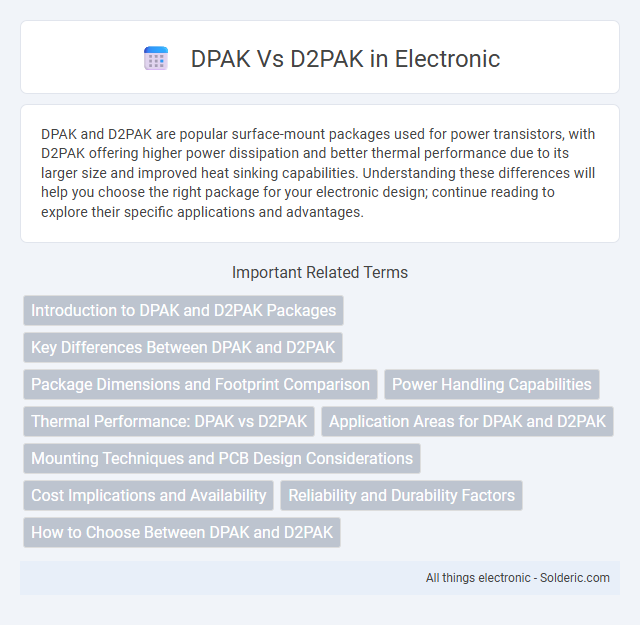DPAK and D2PAK are popular surface-mount packages used for power transistors, with D2PAK offering higher power dissipation and better thermal performance due to its larger size and improved heat sinking capabilities. Understanding these differences will help you choose the right package for your electronic design; continue reading to explore their specific applications and advantages.
Comparison Table
| Feature | DPAK (TO-252) | D2PAK (TO-263) |
|---|---|---|
| Package Type | Surface-mount, small footprint | Surface-mount, larger footprint |
| Size | Approx. 6.7 x 6.5 mm | Approx. 10.4 x 10.4 mm |
| Power Dissipation | Lower, depends on PCB cooling | Higher, better thermal performance |
| Thermal Resistance (Junction-to-Case) | ~15 degC/W | ~3 degC/W |
| Lead Count | 3 leads | 3 leads |
| Application | Low-power switching, small form factor | High-power switching, improved heat dissipation |
| Mounting | Surface mount on PCB | Surface mount on PCB |
Introduction to DPAK and D2PAK Packages
DPAK (Discrete Package) and D2PAK (Discrete Double Package) are popular surface-mount transistor packages commonly used in power electronics for efficient heat dissipation and compact PCB design. DPAK typically supports medium power devices with a smaller footprint, while D2PAK offers larger size and improved thermal performance, making it suitable for higher power applications. Both packages provide robust mechanical stability and easy solder mounting, with D2PAK's increased pin count enabling more complex electrical connections.
Key Differences Between DPAK and D2PAK
DPAK and D2PAK are surface-mount transistor packages with distinct footprint sizes and power dissipation capabilities, where D2PAK typically offers higher power handling due to its larger size and enhanced thermal performance. The pin configuration and mounting style also differ: DPAK is more compact with three leads on one side, while D2PAK features leads extending from two sides, improving mechanical stability. Your choice between these packages depends on your circuit's power requirements and space constraints, optimizing thermal management and board layout efficiency.
Package Dimensions and Footprint Comparison
DPAK (TO-252) features compact package dimensions typically measuring around 6.5mm x 6.5mm with a low profile, making it ideal for space-constrained PCB layouts, whereas D2PAK (TO-263) is larger, generally around 10mm x 15mm, allowing for higher power dissipation due to its increased footprint. The D2PAK's expansive surface area improves heat dissipation capabilities, making it suitable for applications requiring enhanced thermal management compared to the smaller DPAK. Design engineers must consider the trade-off between PCB real estate and thermal performance when selecting between these two packages for power transistors or voltage regulators.
Power Handling Capabilities
DPAK and D2PAK are surface-mount packages commonly used for power transistors, with D2PAK offering higher power handling capabilities due to its larger size and enhanced heat dissipation features. The D2PAK package typically supports power ratings up to 3-5 watts, whereas DPAK ratings are commonly limited to around 2-3 watts, making D2PAK suitable for applications with greater thermal demands. Choosing the right package ensures Your device maintains optimal performance and reliability under specified power conditions.
Thermal Performance: DPAK vs D2PAK
D2PAK offers superior thermal performance compared to DPAK due to its larger size and increased surface area, which enhances heat dissipation capabilities. The improved thermal management in D2PAK packages allows for higher power handling and better reliability in high-temperature environments. Choosing D2PAK can significantly improve your device's thermal efficiency and prolong its operational lifespan.
Application Areas for DPAK and D2PAK
DPAK is commonly used in compact power management applications such as voltage regulators, DC-DC converters, and power supply circuits due to its small footprint and efficient heat dissipation. D2PAK is preferred for higher power applications including automotive electronics, motor drivers, and industrial equipment where better thermal handling and higher current capacity are critical. Your choice between DPAK and D2PAK depends on the power requirements and space constraints of your specific project.
Mounting Techniques and PCB Design Considerations
The DPAK package is designed for surface mounting on PCBs with a smaller footprint, enabling efficient thermal dissipation through a soldered tab directly on the PCB copper area, making it ideal for compact designs. In contrast, the D2PAK package offers a larger thermal pad and greater power handling capability, requiring careful PCB layout with reinforced copper areas and optimized pad sizes to manage heat dissipation effectively. PCB design considerations for DPAK focus on minimizing parasitic inductance and ensuring proper solder fillets, while D2PAK demands robust thermal vias and enhanced copper thickness to support higher current applications.
Cost Implications and Availability
DPAK packages generally offer lower cost implications due to their smaller size and simpler manufacturing process, making them more affordable for high-volume production. D2PAK packages, while typically more expensive, provide better thermal performance, which can reduce overall system costs by enhancing reliability and longevity. Availability for both DPAK and D2PAK remains strong in the market, but DPAK components are more commonly stocked due to higher demand in compact electronics.
Reliability and Durability Factors
DPAK and D2PAK packages differ significantly in reliability and durability due to their thermal performance and mechanical robustness. D2PAK offers enhanced heat dissipation capacity with a larger surface area and thicker leads, which reduces thermal resistance and improves long-term reliability under high-power conditions. The sturdier construction of D2PAK ensures better mechanical stability against vibrations and thermal cycling compared to the more compact DPAK, making it preferable for demanding industrial applications.
How to Choose Between DPAK and D2PAK
Choosing between DPAK and D2PAK depends on power dissipation needs and PCB space constraints; D2PAK offers higher power handling with its larger size, making it suitable for applications requiring better thermal performance. DPAK is preferred for compact designs with moderate power requirements due to its smaller footprint and easier surface-mount assembly. Evaluating thermal resistance, current rating, and board layout compatibility ensures optimal selection for efficient heat dissipation and reliable device operation.
DPAK vs D2PAK Infographic

 solderic.com
solderic.com